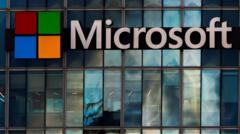Reading view
Siemens says US has allowed chip software sales to China to resume
Agencies create specialist units to help marketers’ solve for AI search gatekeepers
Rising demand among marketers for AI search expertise is driving more agencies to create specialist units intended to help clients navigate the tech and its impact on consumer habits.
In recent months media shops like Jellyfish, Wpromote and Kepler have each launched or expanded AI search services that offer clients a means of partially gauging how applications like ChatGPT and Gemini represent and understand their brands.
Among the advertisers attempting to measure the “share of model” (as opposed to their share of market) within large language models (LLMs) is consumer pharmaceutical firm Haleon. The company is currently testing how Meta’s Llama model represents its Advil and Emergen-C brands in user-generated search results.
Continue reading this article on digiday.com. Sign up for Digiday newsletters to get the latest on media, marketing and the future of TV.
What AI startup Cluely gets — and ad tech forgets — about attention
At first glance, Cluely reads like a parody of startup culture. A 21-year-old founder broadcasting viral videos about chatting on job interviews, dating with AI overlay and hosting parties shut down for “too much aura”.
And yet here we are: Andreessen Horowitz just led a $15 million investment into the startup that turns a person’s screen into an invisible assistant — a kind of real-time whisperer for meetings, sales calls and even exams.
Or at least that’s what it wants to be. Because Cluely launched a narrative before it launched a tool. And somehow, it’s working.
Continue reading this article on digiday.com. Sign up for Digiday newsletters to get the latest on media, marketing and the future of TV.
Media Briefing: ‘Cloudflare is locking the door’: Publishers celebrate victory against AI bot crawlers
This week’s Media Briefing looks into Cloudflare’s new tool that lets publishers block all AI crawlers – at the click of a button – and why publishers are celebrating.
- An end to publishers’ AI crawler Whack-a-Mole
- Google ends tests of a feature that previewed recipes, Forbes CEO shares AI strategy, and more.
Cloudflare’s red-button blocker
Publishers everywhere have had reason to celebrate this week as a single Cloudflare toggle gave them a rare, decisive victory in the battle to keep AI bot crawlers off their content.
This is a member-exclusive article from Digiday. Continue reading it on digiday.com and subscribe to continue reading content like this.
Vogue faces new headwinds as Anna Wintour — who agency execs say made ad dollars flow — shifts focus
Condé Nast execs are pressured to retain ad dollars after Anna Wintour announced last week that she will no longer oversee the day-to-day operations of Vogue, the luxury brand she has led as editor-in-chief since 1988.
Wintour will remain in her broader roles as Condé Nast’s chief content officer and global editorial director for Vogue. And while it’s too soon for the ad industry to record a change in brands continuing to advertise or not, one agency exec acknowledged to Digiday the weight of Wintour’s moves: “[ad money] flows to Vogue because of Anna.”
Wintour has become synonymous with the Vogue brand. But the fashion media landscape has changed since Vogue’s print-dominant heyday. Brands are contending with shrinking referral traffic, ad dollars are shifting to search and social, the creator economy is booming, and generative AI technology is curating fashion and summarizing content in search engines.
Continue reading this article on digiday.com. Sign up for Digiday newsletters to get the latest on media, marketing and the future of TV.
Google brings Veo 3 to all Gemini app ‘Pro’ subscribers worldwide

Veo 3, Google’s latest video generation model, is now available around the world in the Gemini app for AI Pro subscribers.
more…Google rolls out Android TV homescreen update with promoted content in ‘Play Next’

Google is giving Android TV a rare update, with some new promoted categories appearing on the homescreen for some.
more…Meta’s AI climate tool raised false hope of CO₂ removal, scientists say
European CEOs urge Brussels to halt landmark AI Act
How hopeful can we be about AI climate tech?
Whose job is safe from AI?
French B2B neobank Qonto reaches 600,000 customers, files for banking license
U.S. lifts chip software curbs on China amid trade truce
Top 10 Startup and Tech Funding News – July 2, 2025
It’s Wednesday, July 2, 2025, and we’re back with your daily snapshot of where capital is flowing and which startups are commanding attention in the global tech landscape. Today’s edition arrives a little late, but it’s packed with heavyweight deals […]
The post Top 10 Startup and Tech Funding News – July 2, 2025 first appeared on Tech Startups.
Tesla’s Numbers Are In, and They’re Not Good

The electric vehicle maker has posted its second straight quarter of declining deliveries this year, continuing to pay the price for Elon Musk's political turn.
Microsoft Just Fired About 9,000 People While Making Billions

The tech giant is posting staggering profits and leading the AI revolution.
Review: XREAL One’s are incredibly versatile, and they really come to life with the iPad Pro

I’ve been reviewing one of XREAL’s more recent releases of AR glasses: the . These are certainly the most versatile pair of AR glasses I’ve tried out so far, and they actually really come to life somewhere you wouldn’t expect: the M4 iPad Pro running iPadOS 26. come in at just under 3 ounces (84 grams), making them easy to just carry around.
more…Microsoft to cut up to 9,000 jobs as it invests in AI

Watch: Humanoid robots stumble through football match in China
